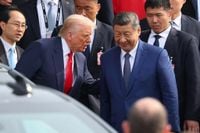In a dramatic turn of events for global trade, Beijing announced on November 4, 2025, that it will halt the global implementation of its October export restrictions on rare earths and related minerals, a move that industry insiders and political leaders alike have described as a potential game-changer. The decision, forged in the wake of a high-stakes summit between U.S. President Donald Trump and Chinese President Xi Jinping in Seoul, signals a temporary easing of the ongoing trade war between the world’s two largest economies. As the dust settles, the ramifications of this agreement are rippling far beyond the negotiating table, impacting supply chains, diplomatic relations, and the global economic outlook.
According to a White House fact sheet and as reported by the South China Morning Post, China will issue general export licenses for rare earths, gallium, germanium, graphite, and antimony—materials essential for chipmaking, battery production, and a broad swath of industrial components found in vehicles, electronics, and renewable energy infrastructure. These controls, imposed in October, had exacerbated the semiconductor supply crisis, especially following China’s export ban and the Dutch government’s intervention on Nexperia earlier in the year. The new agreement also allows trade to resume from Nexperia’s facilities in China, restoring exports of so-called “legacy chips” vital to the automotive sector. For European vehicle manufacturers, who had warned of looming production shutdowns, this comes as a much-needed reprieve.
The U.S.–China accord, however, goes well beyond minerals. The agreement, reached at the Asia-Pacific Economic Cooperation (APEC) 2025 meeting in Gyeongju, South Korea, includes the suspension of Chinese retaliatory tariffs, the reopening of agricultural markets, and commitments to stem the flow of fentanyl precursors to the United States. In return, Washington has pledged to roll back part of its tariff increases on Chinese imports, reducing the average tariff rate from 57% to 47%, and to delay the implementation of additional trade restrictions for one year. As reported by the Washington Post, the summit was described as the "negotiation of the century," signaling a de-escalation in trade tensions that had gripped the world for years.
But why did Washington soften its stance? According to data from the U.S. Bureau of Economic Analysis, the U.S. goods deficit soared to $811.6 billion from January to July 2025—a 21% increase over the previous year. Tariff revenues rose nearly twofold, from $78 billion to $152 billion in the same period, but the increase in the trade deficit outpaced the gains from tariffs. While the U.S. succeeded in reducing its trade deficit with China by nearly $30 billion, this was offset by surging deficits with Vietnam and Ireland. Vietnam’s goods surplus with the U.S. jumped by $30 billion, mirroring the decline in Chinese exports, while Ireland’s surplus ballooned by $40 billion, buoyed by pharmaceutical exports and the surging popularity of obesity drugs in the U.S. As Bloomberg noted, "China still exports $1 billion worth of goods to the U.S. a day," reflecting President Xi Jinping’s enduring bargaining power despite the tariffs.
China’s strategy has been to diversify its export markets, increasing sales to the European Union, ASEAN, and South America. This approach paid off: China’s overall exports continued to grow, even as its shipments to the U.S. declined. Notably, China’s electric vehicle exports soared by 89.4% year-on-year, reaching 1.758 million units in the first nine months of 2025, according to Chinese media cited in Reuters. Meanwhile, the U.S. agreed to allow South Korea to build nuclear-powered submarines, and Nvidia pledged to supply 260,000 GPUs to South Korea, further highlighting the shifting landscape of global technology alliances.
For Europe, the developments have been bittersweet. The European Union was not a party to the U.S.–China negotiations, leaving the bloc dependent on the indirect benefits of the accord. Nonetheless, the European Commission cautiously welcomed Beijing’s suspension of expanded export controls, describing it as “an appropriate and responsible step” to help stabilize global trade flows, according to CTV News. European Commission President Ursula von der Leyen did not mince words about the stakes for Europe, stating that China’s tightening of export controls “has a huge impact on us here in the European Union.” She emphasized that the bloc’s strategy remains focused on “joint purchasing, stockpiling, and investment in strategic projects for the production and processing of critical raw materials here in the EU.” Von der Leyen reiterated Europe’s goal: “to secure access to alternative sources of critical raw materials in the short, medium and long term for our industries.”
Despite the temporary relief, EU officials have made it clear that Europe’s heavy reliance on Chinese materials is a vulnerability they are determined to address. The Critical Raw Materials Act, which aims to diversify supply chains and boost domestic production, remains a top priority. As von der Leyen put it, Europe will continue to “prioritize securing independent access to critical materials and reducing its strategic vulnerabilities.” The European Union’s cautious optimism is tempered by the realization that, while the immediate threat of supply disruptions has eased, the underlying issues of dependency and global competition for resources remain unresolved.
International reaction to the U.S.–China deal has been mixed. The Washington Post hailed the summit as a significant step toward lowering the temperature of the trade war, while cautioning that “some of the leaders’ major pending issues are still unresolved.” Key concerns—such as U.S. semiconductor exports to China and China’s purchases of U.S. soybeans—were left unaddressed. Reuters described the outcome as a “breakable ceasefire,” noting that the root causes of the trade conflict, including China’s industrial policy and export-led growth model, were not on the table. The consensus among analysts is that the agreement marks a pause, not an end, to the economic rivalry between the two superpowers.
Meanwhile, the global trade landscape continues to shift. Taiwan’s export growth, driven by surging demand for AI semiconductors, reached 29.5% in the January-August period. China’s exports to the U.S. may have dipped, but its trade with ASEAN countries hit record highs, bolstered by a sprawling maritime network that includes more than 90 deep-sea ports worldwide. In contrast, traditional manufacturing powerhouses like South Korea, Germany, and Japan have seen sluggish export growth, hampered by structural challenges and intensifying competition from China’s rapidly advancing industries.
As the world watches the evolving dynamics between Washington and Beijing, one thing is clear: the global race for critical minerals and technological supremacy is far from over. The temporary suspension of export controls and tariffs may have brought a momentary calm, but the underlying currents of competition, dependency, and strategic maneuvering remain as turbulent as ever.





